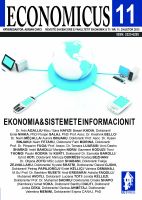Monedha, inflacioni dhe kushtëzimet që vijnë prej modelit neoklasik
Currency, inflation and conditionalities derived from the neoclassical model
Author(s): Florjan SALAJSubject(s): National Economy, Supranational / Global Economy, Financial Markets, Socio-Economic Research
Published by: Shtëpia botuese “UET Press”
Keywords: endogeneous theory of money; inflation; public debt; criticism of the neoclassical theory;
Summary/Abstract: Since 2013 and after, an economic debate has been initiated in Albania with unprecedented records, capsulating the entire public opinion. The governemnt’s decision to change the entire structure of taxation from flat tax to progresive tax was encountered with harsh contradiction by different interest groups. Although, the austerity measures taken by the Albanian goverenment, were justified as neccessary, as result of agravated economic-financial conditions, high levels of public depts, increase of problematic loans related to the entire bank portofolio, decrease of fundings to the private economic sector and also negative expectations in relation to the gross domestic production, still the only solution taken in consideration by the Albanian governemnt, despite endogeneous alternatives, was to finance the Albanian public dept by the IMF funds. Due to inflation fear, solutions like “Quantitive Easing” or printing new banknotes were left aside. As a consequence, in the economy, not even a single public incentives was taken in consideration, leaving the performance of the economy, in the hands of banks and private investors, based on restricted financial policies according to the neoclasical school of thoughts. The aim of this paper is to present the endogeneous theory of money, based on empirical data, in order to remove existing neoclasical theory taboos, like the existence of direct links from monetary basis to inflation, direct result of the monetary school, so to provide an additional hint toward the exploration of other dinamic supply/demand economic variable models.
Journal: ECONOMICUS
- Issue Year: 11/2013
- Issue No: 1
- Page Range: 34-42
- Page Count: 9
- Language: Albanian

